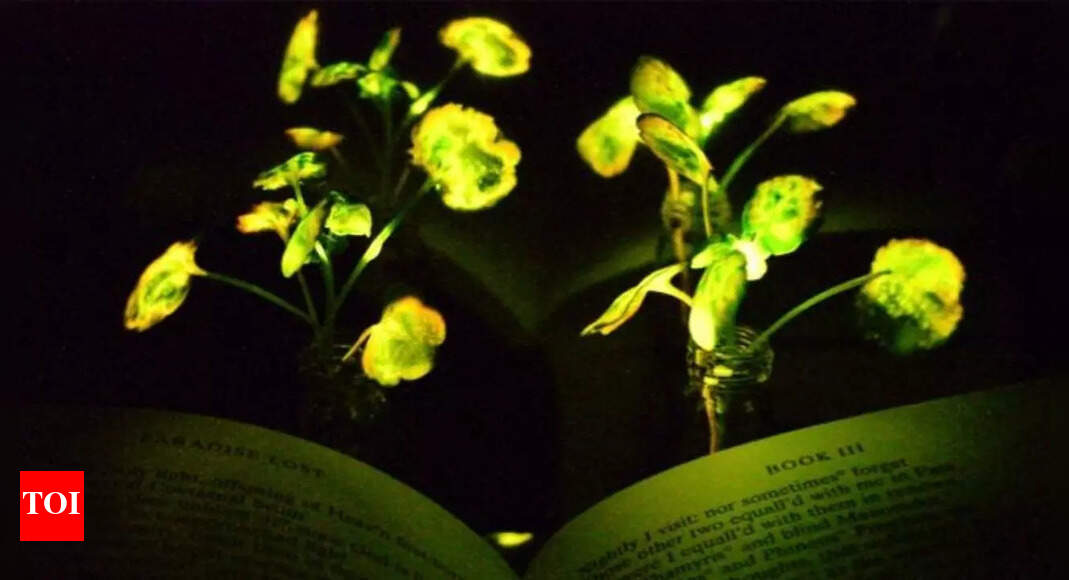Researchers have developed glowing plants that shine in vivid shades of green, red, and blue, offering a sustainable alternative to traditional lighting systems. The study, published in the journal Matter, reveals how succulents infused with afterglow phosphor particles can naturally absorb sunlight or LED light and gradually release it, creating a soft glow lasting up to two hours. Unlike earlier attempts that struggled with dim or uneven results, this breakthrough allows plants to emit multicolour luminescence bright enough to rival small night lights. Inspired by the glowing forests of Avatar, scientists envision plant-based lighting transforming urban spaces, gardens, and homes into eco-friendly, bioluminescent environments that reduce energy consumption while blending nature with futuristic design.
South China Agricultural University develops sustainable glow-in-the-dark succulent plants
Scientists from South China Agricultural University, led by first author Shuting Liu as reported in CellPress (Matter), created glow-in-the-dark succulents that recharge naturally under sunlight or LED light. These plants shine with enough brightness to rival small night lamps, offering a cost-effective and eco-friendly alternative to artificial lighting.The research team used afterglow phosphor particles—materials capable of absorbing and slowly releasing light—giving the plants a vibrant glow that lasts up to two hours after exposure. “Picture the glowing forests from Avatar, where luminescent plants light up entire landscapes,” Liu explains. “Our goal was to make this vision a reality with materials already available in the lab. Imagine glowing trees replacing conventional streetlights.”Beyond aesthetics, this discovery holds immense potential in urban planning, architecture, and sustainable design, where plant-based illumination could reduce energy consumption while creating futuristic landscapes.
Micron-sized phosphor particles enable bright multicolour glowing succulents
For years, scientists struggled with plant luminescence due to technical limitations:
- Nano-sized particles spread easily inside plants but produced weak, dim light.
- Larger particles emitted brighter light but couldn’t travel efficiently through plant tissues.
To overcome this, the team introduced micron-sized afterglow particles (>5 μm) into Echeveria ‘Mebina’, a succulent with a unique leaf microstructure. Its narrow, evenly distributed internal channels allowed particles to diffuse uniformly, resulting in bright, multicolour luminescence without compromising plant health.
Succulents power low-cost glowing plant wall with bright, sustained luminescence
Unlike earlier attempts, this technique bypasses the traditional trade-off between particle size and brightness. The succulents demonstrated a bright, sustained glow after just minutes of light exposure—either from natural sunlight or indoor LEDs.While non-succulent plants like golden pothos and bok choy were also tested, only succulents produced strong luminescence due to their structural efficiency in dispersing particles.Liu admitted the results were surprising: “We expected plants with airy tissue structures to perform better, but succulents diffused particles within seconds, lighting up their entire leaves.” To showcase real-world applications, the researchers constructed a glowing succulent wall with 56 plants arranged together. This wall produced enough brightness to illuminate nearby objects and even allowed researchers to read text without additional lighting.Each plant required only 10 minutes of preparation and cost about 10 yuan ($1.4 USD) excluding labor—highlighting its low-cost, scalable potential.
Future applications of plant-based lighting
Although the glow fades gradually and long-term safety studies are still underway, the findings open up new possibilities:
- Sustainable outdoor lighting: glowing plants could illuminate pathways, gardens, or parks.
- Indoor aesthetic design: plant-based lighting for decor, ambient light walls, or eco-friendly interior designs.
- Urban architecture: futuristic bioluminescent landscapes integrated into city planning.
Researchers continue exploring how to expand the technique beyond succulents, aiming for larger plants and trees that could replace low-intensity streetlights in the future.This pioneering research not only demonstrates a practical method for multicolour glowing plants, but also brings us closer to an era where living organisms can serve as natural lighting sources. If scalable, this technology could dramatically reduce reliance on artificial lighting systems, merging biology and sustainability in ways once seen only in science fiction.Also Read | Blood Moon lunar eclipse on September 7: When and where to watch the rare total lunar eclipse in India
